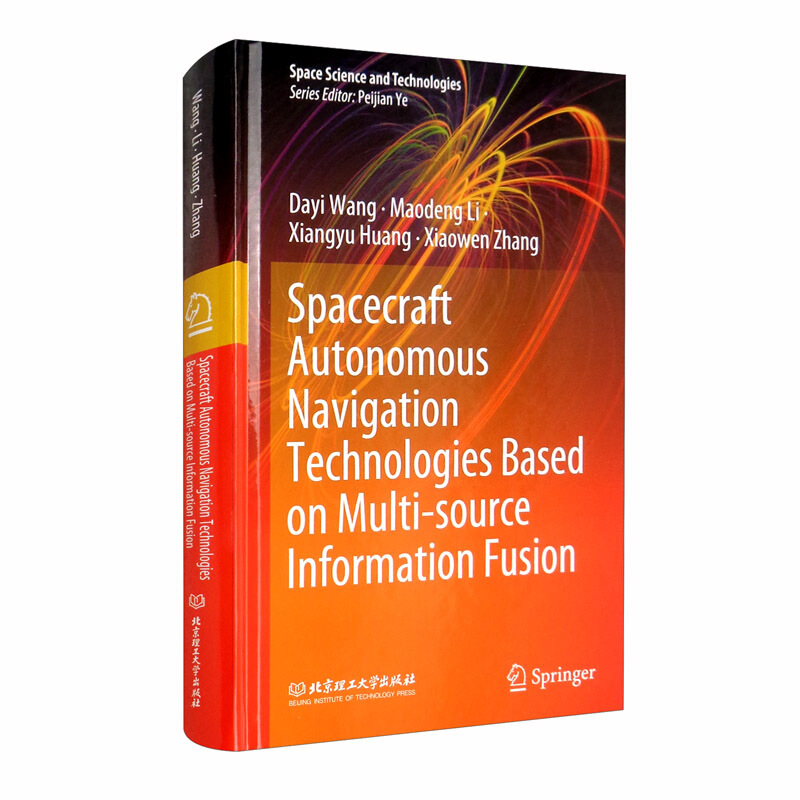
包邮航天器多源信息融合自主导航技术=Spacecraft Autonomous

- ISBN:9787568290081
- 装帧:一般胶版纸
- 册数:暂无
- 重量:暂无
- 开本:16开
- 页数:340
- 出版时间:2020-09-01
- 条形码:9787568290081 ; 978-7-5682-9008-1
内容简介
This book introduces readers to the fundamentals of estimation and dynamical system theory, and their applications in the field of multi-source information fused autonomous navigation for spacecraft. The content is divided into two parts: theory and application. The theory part (Part I) covers the mathematical background of navigation algorithm design, including parameter and state estimate methods, linear fusion, centralized and distributed fusion, observability analysis, Monte Carlo technology, and linear covariance analysis. In turn, the application part (Part II) focuses on autonomous navigation algorithm design for different phases of deep space missions, which involves multiple sensors, such as inertial measurement units, optical image sensors, and pulsar detectors. By concentrating on the relationships between estimation theory and autonomous navigation systems for spacecraft, the book bridges the gap between theory and practice. A wealth of helpful formulas and various types of estimators are also included to help readers grasp basic estimation concepts and offer them a ready reference guide.
目录
1.1 Autonomous Navigation Technology
1.1.1 Inertial Navigation
1.1.2 Autonomous Optical Navigation
1.1.3 Autonomous Pulsar-Based Navigation
1.2 Multi-source Information Fusion Technology
1.2.1 Definition of Multi-source Information Fusion
1.2.2 Classification of Multi-source Information Fusion Technologies
1.2.3 Multi-source Information Fusion Methods
1.3 Autonomous Navigation Technology Based on Multi-source Information Fusion
1.3.1 Research and Application Progress
1.3.2 Necessity and Advantages
1.4 Outline
References
2 Point Estimation Theory
2.1 Basic Concepts
2.2 Common Parameter Estimators
2.2.1 MMSE Estimation
2.2.2 ML Estimator
2.2.3 Maximum a Posteriori (MAP) Estimator
2.2.4 Weight Least-Square (WLS) Estimator
2.3 Closed Form Parameter Estimators
2.3.1 Linear Estimator
2.3.2 MMSE Estimator for Jointly Gaussian Distribution
2.3.3 Estimation Algorithms for Linear Measurement Equation
2.4 State Estimation Algorithms in Dynamic Systems
2.4.1 Recursive Bayesian Estimation
2.4.2 Kalman Filtering
2.4.3 Extended Kalman Filtering
2.4.4 Unscented Kalman Filtering
2.4.5 Constrained Kalman Filtering
2.5 Brief Summary
References
……
3 Estimation Fusion Algorithm
4 Performance Analysis
5 Time and Coordinate Systems
6 Dynanuc Models and Environment Models
7 Inertial Autonomous Navigation Technology
8 Optical Autonomous Navigation Technology
9 Optical/Pulsar Integrated Autonomous Navigation Technology
10 Altimeter and Velocimeter-/Optical-Aided Inertial Navigation Technology
11 Simulation Testing Techniques for Autonomous Navigation Based on Multi-source Information Fusion
12 Prospect for Multi-source Information Fusion Navigation
Appendix
作者简介
王大轶,研究员,现任中国空间技术研究院总体部副部长,中国宇航学会英文刊Advances in Astronautics Science and Technology(《航天科技前沿》)编委,国家杰出青年科学基金获得者,国防科技卓越青年科学基金获得者,国家万人计划科技创新领军人才,“973项目”技术首席专家。在航天器自主导航与控制领域进行创新研究工作,解决了一系列关键技术问题,为嫦娥月球探测器等型号飞行试验成功做出了贡献。2016年获何梁何利基金科学与技术创新奖,2017年入选***百千万人才工程,是国务院政府特殊津贴专家、国家有突出贡献中青年专家。获国家技术发明二等奖1项,部级一等奖4项、二等奖4项。
-

发电厂电气部分
¥34.6¥58.0 -

植物进化的故事
¥19.9¥59.0 -

赶往火星:红色星球定居计划
¥44.5¥58.0 -

数控车工
¥5.9¥11.5 -

低空无人机集群反制技术
¥82.6¥118.0 -

数据驱动的剩余寿命预测与维护决策技术
¥63.4¥79.0 -

手术机器人导航与控制
¥127.4¥169.8 -

射频干扰袖珍手册
¥18.4¥29.0 -

汽车车身构造与修复
¥30.7¥45.0 -

群目标分辨雷达初速测量技术
¥42.4¥69.0 -

秸秆挤压膨化技术及膨化腔流道仿真研究
¥40.6¥55.0 -

NVH前沿科技与工程应用
¥109.7¥159.0 -

电力系统分析
¥23.8¥38.0 -

继电保护原理
¥30.4¥49.0 -

不确定条件下装备剩余寿命预测方法及应用
¥60.4¥99.0 -

船舶分段装配
¥58.6¥80.0 -

基于深度学习的复杂退化系统剩余寿命智能预测技术
¥54.4¥89.0 -

火星探测器轨道动力学与控制
¥59.8¥98.0 -

美军联合作战弹药保障
¥35.8¥58.0 -

工程造价全过程管理系列丛书 工程结算与决算 第2版
¥37.4¥56.0











